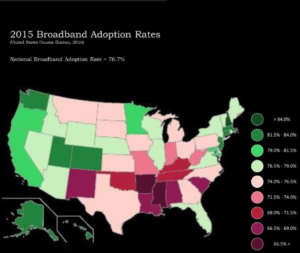Internet access, particularly a high quality, high-speed broadband connection, has become a key requirement for successful integration into the modern workforce, access to health information, public safety, economic development of the region, civic participation, and to access educational and other professional opportunities.
Federal programs and resources such as the Rural Utilities Service (URS) of the U.S. Department of Agriculture and the Universal Service Fund (USF) of the Federal Communications Commission (FCC) — particularly the USF programs Lifeline and the Connect America Fund — exist to increase access to broadband infrastructure in rural areas [see Congressional Research Report: ‘Broadband Internet Access and the Digital Divide: Federal Assistance Programs’]. But despite nationwide increases in fixed broadband availability and adoption[1] over the past fifteen years (FCC report: ‘Internet Access Services: Status as of December 31, 2015’, p.7), rural areas continue to lag behind urban areas in terms of broadband infrastructure availability.
FCC data indicate that while 96% of urban households live in an area where high-speed broadband infrastructure is available, only 61% of rural households and 32% of households on tribal lands live in regions with the same infrastructure, as of 2014 (these estimates do not pertain to individual households with access, but rather households located in a region that has at least partial infrastructure access) (FCC 2016 Broadband Progress Report, p.34). The FCC’s high-speed broadband deployment map shows where in the U.S. 25 mbps/3 mbps fixed broadband infrastructure is available (last updated in 2016): http://www.fcc.gov/reports-research/maps/bpr-2016-fixed-25mbps-3mbps-deployment
However, availability of broadband technology in a geographical area does not mean that all or even a majority of households in this region have also adopted broadband, meaning that they have a subscription which allows them to use high-speed broadband at home. American Community Survey (ACS) data, for which households report directly whether they have a broadband subscription, indicate that the nationwide residential broadband adoption rate is only 76.6% as of 2015 (the most recent available ACS data) (American Community Survey 2015 broadband adoption data). The map below visualizes the 2015 ACS data on adoption rates by state (source: https://ncbroadband.gov/broadband-access-the-future-for-small-rural-farmers).

Many of the disconnected communities are doubly disadvantaged in that those communities lacking high-speed broadband access and with that reliable access to critical health and safety information and employment opportunities, are typically also most affected by health disparities, high unemployment rates, and lack of access to other educational opportunities (LaRose et al., 2007; Warren, 2017; FCC’s 2016 Broadband Progress Report, p.42).
In a recent statement, FCC Commissioner Mignon L. Clyburn stated that “according to the Center for Public Integrity, families in our nation’s higher poverty areas are nearly five times more likely not to have access to broadband speeds of 25 Mbps/3 Mbps, than those residing in the most affluent areas. These are areas of persistent poverty – communities that would actually benefit the most from connectivity – and they are populated by those who are cut off from job opportunities, and remain at a marked disadvantage, when it comes to education, healthcare, government services and civic participation” (Clyburn, statement Connect America Fund, WC Docket No. 10-90).
However, broadband infrastructure is only a prerequisite for adequate digital inclusion, not a sustainable solution in itself. Research examining the economic impacts of broadband access in rural regions in the U.S. found a stark difference in economic outcomes when ‘access’ was defined as the availability of broadband infrastructure versus ‘access’ being defined as the adoption of a residential broadband connection. Broadband infrastructure alone provided only minimal economic benefits to households and regions, while increased broadband adoption was linked to individual-level and community-level economic improvements (Whitacre et al., 2014a; Whitacre, 2014b).
The cost of fixed broadband subscriptions is often cited as the single most important factor in hindering broadband adoption in areas where the infrastructure is available. However, research suggests that while affordability is certainly key, there are also other factors that should be considered. One well-cited cross-country analysis of cultural factors affecting broadband adoption lists lack of understanding of the services and content that can be accessed online as one reason individuals in the U.S. may not adopt high-speed broadband, as well as an actual insufficiency in online content relevant to a particular community (Fife & Pereira, 2002, Socio-Economic and Cultural Factors Affecting Adoption of Broadband Access: A Cross-Country Analysis).
To truly equalize the digital playing field, we need to carefully consider the factors affecting individuals’ ability to gain high-speed broadband access once the infrastructure becomes available in their geographic region. The findings cited here speak to the importance of investments in educational programs and services addressing digital literacy, content creation, and other aspects critical to sustainable broadband adoption.
______________________
[1] In the FCC report, broadband adoption is defined as “the number of residential connections to fixed broadband at or above the specified level of speed divided by the total number of households in the area with access to fixed broadband services advertised at or above the specified level of speed” (FCC’s 2016 Broadband Progress Report, p.45). This is not the only possible definition of broadband adoption. For example, NDIA offers a more practical, comprehensive definition, informed by NDIA affiliates.

Jana Wilbricht is a Ph.D. Candidate in Communication Studies at the University of Michigan, and worked with NDIA during the summer 2017 as a research fellow of the Consortium on Media Policy Studies (COMPASS). You can reach her via e-mail at [email protected] and follow her on Twitter @Jana_Wil.
